The OnePlus 3 Review
by Brandon Chester on June 20, 2016 8:00 AM EST- Posted in
- Smartphones
- OnePlus
- OnePlus 3
System Performance
2015 was not a great year for Android devices. Snapdragon 810’s problems with throttling severely crippled the performance of high end smartphones. In the case of the OnePlus 2, OnePlus went even farther by putting in code that would detect when Google Chrome was in use and completely shut off the A57 cluster on the SoC. This resulted in web browsing performance that was essentially no better than what you’d find on a $100 phone shipping with Snapdragon 410, which simply wasn’t acceptable given the fact that the OnePlus 2 was priced at around $400.
Like most of this year’s flagship Android devices, the OnePlus 3 uses Qualcomm’s Snapdragon 820 SoC. We looked at Snapdragon 820 not long ago in the LG G5 review and saw that it provided a substantial improvement over Snapdragon 810, which became even greater when you consider prolonged workloads where Snapdragon 810’s A57 cores throttle down and shut off. Given that OnePlus no longer has any reason to put in strange app detection code to manage thermals, we should see a good uplift in general performance and an enormous improvement in web performance.
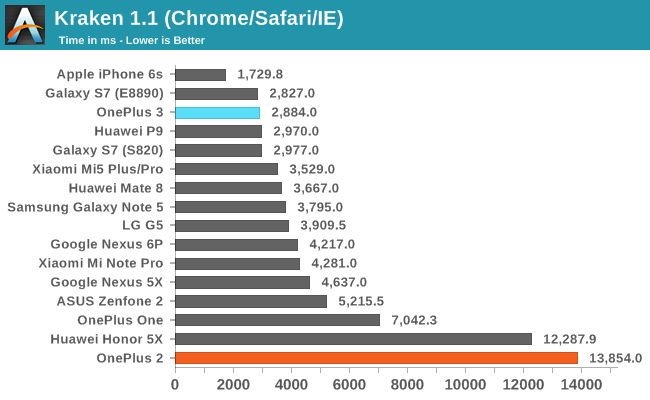
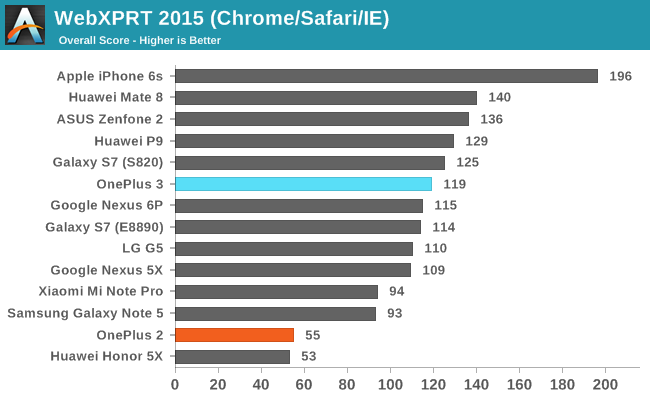
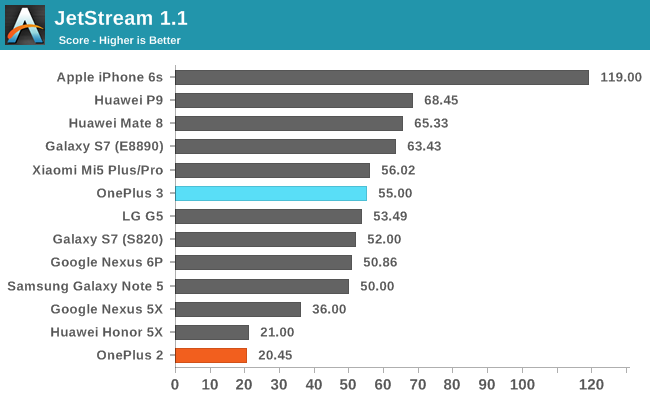
The improvement in web browsing performance when going from the OnePlus 2 to the OnePlus 3 is staggering. This isn't unexpected when you consider that the OnePlus 2 was just running on Cortex A53 cores that were meant for low power scenarios while the OnePlus 3 is using Qualcomm's Kryo cores. In Kraken the OnePlus 3 is over four times faster, while in WebXPRT and JetStream it's at least over two times faster. The OnePlus 2 actually represented a large regression in web performance compared to its predecessor, and OnePlus has brought web performance back to a level that is competitive with the other smartphones on the market with the OnePlus 3.

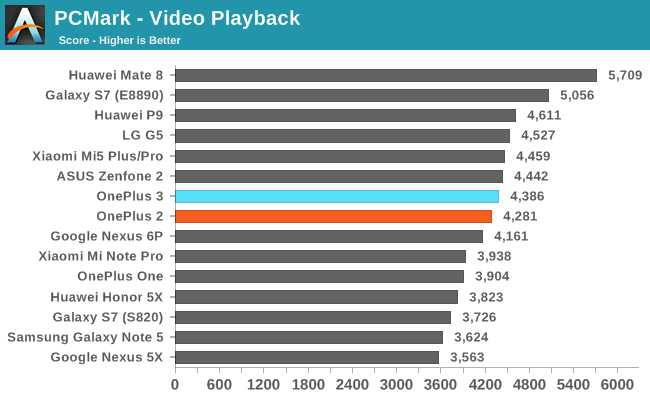

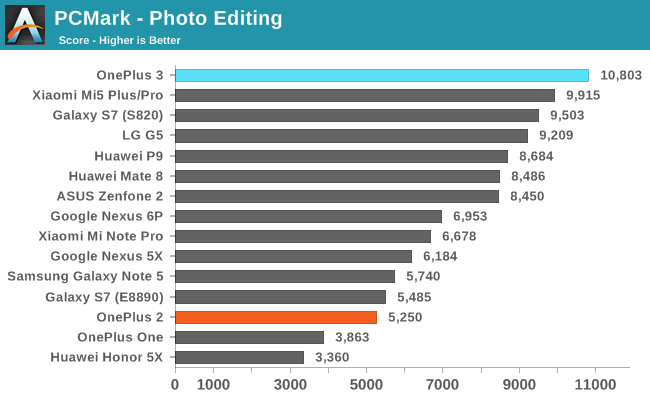
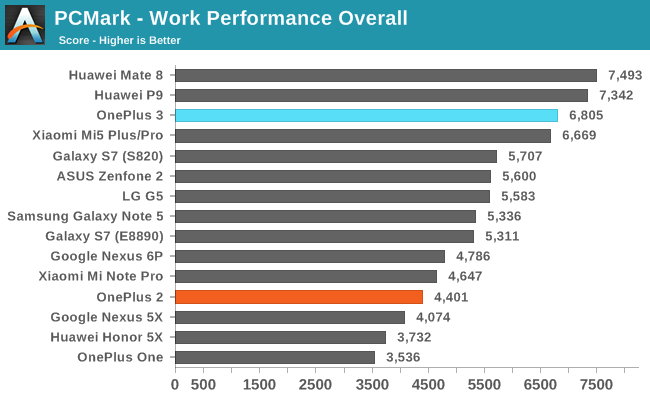
PCMark is an interesting test because it depends just as much on a phone's software as it does on the hardware. We've seen how devices with the same SoC can perform very differently, especially in certain sub-tests like the Writing and Photo Editing tests where different runtime and OS optimizations can have a large impact. The OnePlus 3 is no exception, with it achieving higher scores than the LG G5 in every test except for video playback where they have roughly the same scores.
This is not unexpected, as it was demonstrated in the LG G5 review that the G5 has more conservative frequency scaling than the other Snapdragon 820 devices that we've seen, which is reflected in PCMark's tests. In any case, the OnePlus 3 actually gets close to the Huawei Mate 8 in the writing test, and beats it and the LG G5 by a large margin in the photo editing test. In the end the OnePlus 3 places second on our overall chart, with only the Huawei Mate 8 ahead of it, and the gap between it and the Mate 8 being smaller than the gap between it and the Zenfone 2 which is the next fastest smartphone.
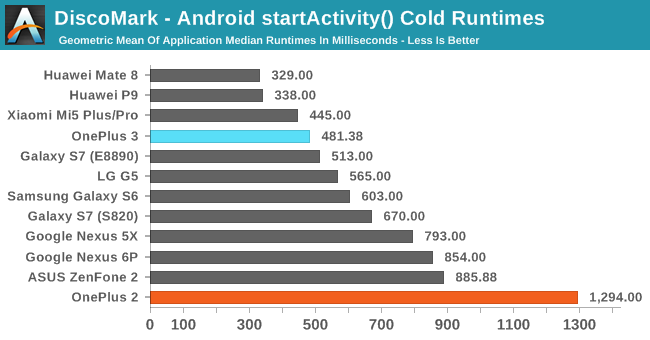
The OnePlus 3 is over two times faster than the OnePlus 2 with cold app launches where the application isn't resident in memory in any state. This is likely a combination of improved NAND performance, and changes to OnePlus's DVFS settings in addition to the performance improvements that Snapdragon 820 provides on its own. The impact that this has on the performance of the interface is significant, and when I reviewed the OnePlus 2 I noted how painfully slow it was to move around and through the applications. This new testing is a great example of that, with the OnePlus 2 taking 1.3 seconds just to launch apps, while the OnePlus 3 takes under 500ms and is the second fastest device here.
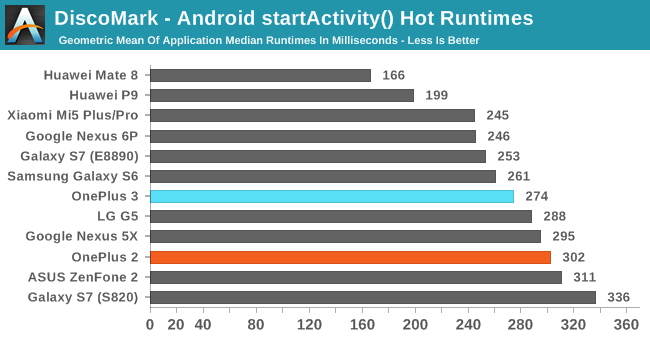
The OnePlus 3 improves a bit over the OnePlus 2 when resuming apps that are resident in memory, but not by a great deal. In general, all our devices hover between 250 and 300ms here, with the exception of the Huawei Mate 8 and P9 which are really in a category of their own for performance. While there's no enormous improvement here, the OnePlus 3 is competitive with other high end devices in the market, so there's nothing to complain about either.
One thing worth noting is that our set of apps wouldn't come close to utilizing the OnePlus 3's 6GB of RAM. Unfortunately, no matter how many apps we added, this would actually still be the case. The reason is that OnePlus has implemented very aggressive app eviction from memory, which means that your 6GB of RAM is really just sitting there using energy, and in general the utilization is pretty low. This may be a holdover from when the OnePlus 2 shipped in a 3GB configuration, but it's something OnePlus needs to address in a future OTA update. I'd imagine the Android enthusiast community is already at work on, or has already created custom kernels to alter this behavior as well. With 6GB of RAM you should be able to comfortably keep all of a user's frequently used apps resident in memory.
It's great to see that OnePlus is producing a smartphone with competitive performance once again. When the OnePlus One launched, Snapdragon 801 was the best you could get in an Android smartphone. The OnePlus 2 was an unfortunate victim of Snapdragon 810's heat and throttling problems, but OnePlus certainly didn't help the issue by hardcoding in mechanisms to detect Google Chrome and shut the A57 cluster off entirely. With the OnePlus 3 you get some of the best CPU performance in an Android phone, with PCMark's real-world tests demonstrating noticeable gains over the LG G5 which also uses Snapdragon 820. If I had to sum things up in a single line I'd just say that it's good to see that OnePlus is back in the game.


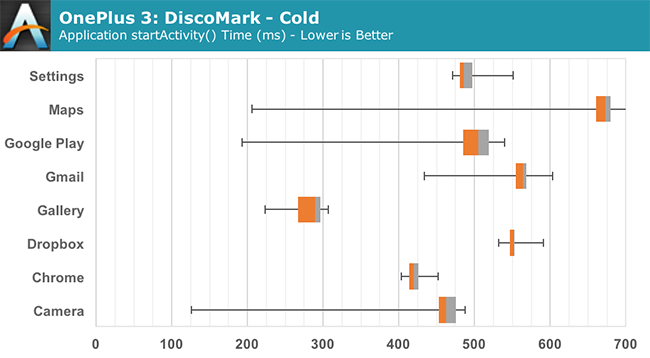
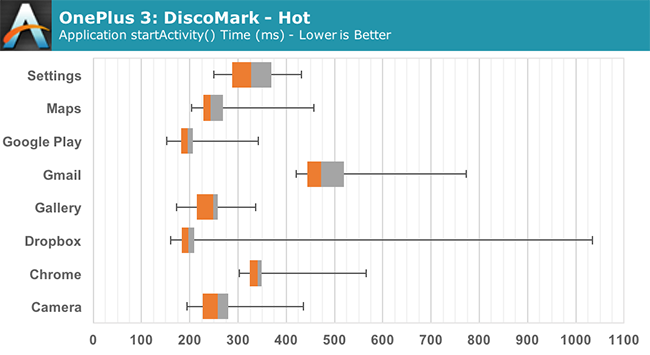








176 Comments
View All Comments
fanofanand - Monday, June 20, 2016 - link
Not to mention I call BS on his entire statement. You really sit around the water cooler with your colleagues discussing the screen quality of your phone? You discuss how great the colors are? Unless you work for a mobile phone manufacturer, you are either lying or the most boring guy in the office.shktr - Monday, June 20, 2016 - link
I work at an IT company. Talking about new tech on a daily basis. So why would it be BS? Who wouldn't discuss their brand new phone and its performance? That aside, I'm curious why most of the people that review the phone are positive about the display? They are all lying? I agree its not the best out there. Yet saying its a poor display is just wrong.UtilityMax - Wednesday, June 22, 2016 - link
I am not a big display quality nut, but the two things I really care about is max brightness and black levels, which basically means that I expect the screen to look good to an untrained eye, either outdoors or in the dark. So it is disappointing to see that Oneplus 3 has max brightness about on the level of Asus Zenfone 2. A lot of people thought this was not even acceptable on a 200-300 dollar device which Zenfone 2 was, but for a 400USD 2016 "flagship killer" it's ridiculous.Eden-K121D - Monday, June 20, 2016 - link
Yep.People should stop whining and accept the fact that oneplus 3 has a POOR displaygrayson_carr - Monday, June 20, 2016 - link
If you call the OnePlus 3 display poor, then I think you have to call the Galaxy S7 display poor as well because by default its display is no more accurate than the OnePlus 3 display. You have to change the display mode from adaptive to basic to make the S7 display accurate, which let's be honest, only about 0.1% of people who buy the S7 do that. I think Anandtech needs to start publishing display measurements using the default display settings as they come out of the box, because that's what 99.9% of people will use and see when they buy the phone. I'm fine with including measurements of the basic mode as well, but I don't think it should be the only measurements shown. The default settings should be measured and discussed considering that's how most people, even enthusiasts who read this site, will use it.Eden-K121D - Tuesday, June 21, 2016 - link
At Least they give an option to change the mode. Oneplus doesn't even do thatLolimaster - Wednesday, June 22, 2016 - link
You have the option and if you care about accuracy you will use it.Avrg people like colors to poop but once you show them how the colors should look (specially when white/black/greyscale are involved) they dont look back after switching to "basic".
Brandon Chester - Monday, June 20, 2016 - link
The screen is not better than the OnePlus One at all. There's no subjectivity here, these are purely objective measurements. If someone enjoys that a display shows completely inaccurate gaudy colors and has a severely blue-shifted white point, there's nobody trying to stop them from enjoying it.An analogy: I enjoy The Room, but I would never try to argue that it's an objectively high quality film on the basis that I enjoy it. You can enjoy a display with poor image rendition, but that doesn't make it good.
grayson_carr - Monday, June 20, 2016 - link
While we're complaining about gaudy colors and shifted white points, I would like to request that Anandtech start publishing display measurements for the default display modes of phones. For example, the Galaxy S and Note lines and the Nexus 6P both ship with displays with gaudy colors and shift white points but default, but we never see those measurements, but just the measurements after you have set them to sRGB mode. The problem with that is that 99.9% of people who buy those phones leave the display settings at the default. I would bet you cold hard cash that even the majority of Anandtech readers leave the display settings at default. And so now we have a bunch of people running around claiming "Anandtech said my phone has like the most accurate display, dude", but then I look at their phone, and uhhh, no. They are using the default display mode and have been mislead into thinking those colors are accurate. I realize that most Anandtech readers aren't dumb enough to pull that, but the problem is, when Anandtech publishes its findings, a bunch of other news outlets come along and say "Anandtech and DisplayMate say this phone displays the most accurate colors ever", but conveniently leave off the part about have to change settings for that to be true. I'm not saying you should test and publish the results in the sRGB modes. You should. I'm just saying you should ALSO publish the results for the default display settings for a device. And if the accuracy sucks at the default settings, you should call it out and complain about it a bit, even if there is an sRGB setting buried in developer options somewhere. You can tell me the Galaxy S7 has a more accurate display than the iPhone 6S all you want, but if I run meet two people when I'm out and one has an S7 and one has a 6S, guess which one is going to be more accurate 99.9% of the time?/rant
grayson_carr - Monday, June 20, 2016 - link
Err, should have proofread before posting. Autocorrect killed me and there's no edit button."I'm not saying you *shouldn't test and publish the results in the sRGB modes."